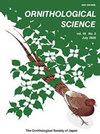埃及夜莺口咽腔的大体解剖和超微结构特征:功能性饮食意义
IF 0.3
4区 生物学
Q4 ORNITHOLOGY
引用次数: 10
摘要
摘要关于鸟类口腔形态与饮食生态位的比较,已有大量文献,但对夜壶(Caprimulgidae,Caprimuljiformes)的研究很少。在此,我们使用大体解剖分析和扫描电子显微镜描述了埃及埃及夜壶的口咽腔。埃及伊蚊的舌头很短,顶端钝,有许多鳞片状结构。舌头的身体有小的和大的圆锥形乳头,用于捕捉和取回昆虫,并通过一个明显的乳头嵴与根部分离。喉丘以喉沟为界,喉沟中央有声门裂,声门裂前部有两个喉褶,尾部有两个圆锥形乳头列。唾液腺分布在舌体和舌根、口咽腔底、上颌前部和腭后部。上腭分为乳头状区和非乳头状区。此外,乳头状区域的中间部分有两个主要裂隙:后肛门裂隙和漏斗裂隙。在腭的后缘,有一排横向的大的尾状圆锥形乳头。我们的研究结果揭示了埃及伊蚊舌乳头、唾液腺分布和腭结构的多种结构和功能适应,反映了该物种的食虫饮食习惯。本文章由计算机程序翻译,如有差异,请以英文原文为准。
Gross Anatomical and Ultrastructural Characterization of the Oropharyngeal Cavity of the Egyptian Nightjar Caprimulgus aegyptius: Functional Dietary Implications
Abstract Much literature exists on the comparative oral morphology of birds in relation to dietary niche, but little research has been done on the nightjars, (Caprimulgidae, Caprimulgiformes). Herein, we describe the oropharyngeal cavity of the Egyptian nightjar, Caprimulgus aegyptius, using gross anatomical analysis and scanning electron microscopy. The tongue of C. aegyptius is short with a blunt apex carrying numerous scale-like structures. The body of the tongue has both small and large conical papillae for capturing and retrieving insects, and is separated from the root by a distinct papillary crest. The laryngeal mound is bounded by a laryngeal groove with a median glottic fissure that bears two laryngeal folds rostrally and two conical papillary rows caudally. Salivary glands are scattered on the lingual body and root, the floor of the oropharyngeal cavity, and the anterior maxillary and posterior palatine regions. The palate is divided into papillary and non-papillary regions. Furthermore, the median portion of the papillary region has two main clefts: the choanal and infundibular clefts. At the rear edge of the palate, a single transverse row of large caudally-directed conical papillae is present. Our findings reveal multiple structural and functional adaptations of the lingual papillae, salivary gland distribution, and palatal architecture in C. aegypitus that reflect the species' insectivorous dietary habits.
求助全文
通过发布文献求助,成功后即可免费获取论文全文。
去求助
来源期刊

Ornithological Science
ORNITHOLOGY-
CiteScore
1.20
自引率
0.00%
发文量
26
审稿时长
>12 weeks
期刊介绍:
Ornithological Science publishes reviews, original articles, short communications and comments covering all aspects of ornithology. Manuscripts are judged on the basis of their contribution of original data and ideas or interpretation. All articles are peer-reviewed by at least two researchers expert in the field of the submitted paper. Manuscript are edited where necessary for clarify and economy. Ornithological Science aims to publish as rapidly as is consistent with the requirements of peer-review and normal publishing constraints.
 求助内容:
求助内容: 应助结果提醒方式:
应助结果提醒方式:


